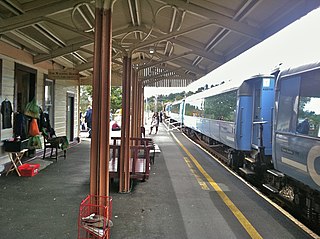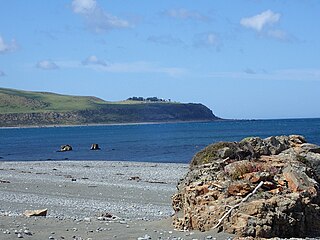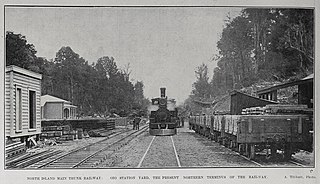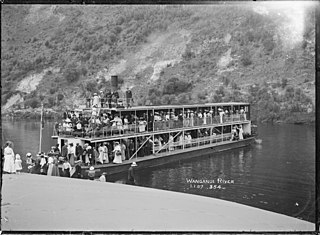
The Ahaura River is in the South Island of New Zealand. This river drains the western flanks of the Southern Alps and flows into the Grey River.

The Stillwater Ngākawau Line (SNL), formerly the Stillwater–Westport Line (SWL) and the Ngakawau Branch, is a secondary main line, part of New Zealand's national rail network. It runs between Stillwater and Ngakawau via Westport on the West Coast of the South Island. It was one of the longest construction projects in New Zealand's history, with its first section, at the south end, opened in 1889, and the beginnings of the Ngākawau Branch, at its Westport end, in 1875. The full line was completed in 1942. The only slower railway projects were Palmerston North to Gisborne, 1872 to 1942, and the Main North Line to Picton, 1872 to 1945.

TSS Arahura was a twin screw steam passenger/cargo ship built for the Union Steam Ship Company. It was launched on the Clyde on 25 March 1905 and built by William Denny and Brothers Dumbarton at a cost of £52,000. It had a gross weight of 1,607 tons. The ship had accommodation for 201 passengers.

Ohakune railway station is a station on the North Island Main Trunk (NIMT), which serves the town of Ohakune in the Manawatū-Whanganui region of New Zealand. It is served by KiwiRail's Northern Explorer long distance train between Wellington and Auckland. It was called Ohakune Junction from 10 August 1926 until Raetihi Branch closed in 1968, to avoid confusion with Ohakune Town station on that branch. It was the second highest operating railway station in New Zealand, after National Park.

Feilding railway station was a station on the North Island Main Trunk line in Feilding, New Zealand. It was opened on 1 October 1876 and closed on 25 June 2012. The station is now used by Feilding Information Centre and an occasional excursion train.

Marton railway station was a station and rail junction on the Marton–New Plymouth Line, opened on 4 February 1878. After the North Island Main Trunk (NIMT) made a junction to the south of Marton, a new station was built there and the old station renamed and downgraded, in 1898.

Fitzroy Bay is a bay close to the entrance of Wellington Harbour in New Zealand. It lies to the southeast of the entrance to the harbour, between Pencarrow Head and Baring Head. Lake Kohangatera drains into the bay through Gollans Stream.

Kakahi was a station on the North Island Main Trunk line, in the Ruapehu District of New Zealand, serving Kakahi. It formally opened on 9 November 1908. The rails were laid south of Piriaka by May 1904 and a daily ballast train was running by October, which also carried passengers. Kakahi Bridge has five spans of 44 ft (13 m) and one of 23 ft (7.0 m) supplied by G. Fraser & Sons of Auckland, which delayed construction to the south. It crosses the Kakahi Stream, which was sometimes called the Waitea River.

SS Hilonian was a general passenger and cargo steamer, built as the Triumph in 1880 at Middlesbrough for McIntyre & Co, and later fitted with refrigeration equipment and leased to Shaw Savill and the New Zealand Shipping Company. She sank and ran aground many times, the final sinking being by torpedo in 1917.

SS Go Ahead was a twin screw-steamer, launched on the afternoon of Saturday 20 April 1867 by Seath and Connell, of Rutherglen, for the Clyde Shipping Company, with a plan to use her in New Zealand coastal trading. She had 30, or 35 hp (26 kW), high pressure engines, and tubular boilers from Campbell & Son's foundry.

Oio was a station on the North Island Main Trunk line, in the Ruapehu District of New Zealand. It served the hamlet of Oio, which lay to the north of the station. It was 8.29 km (5.15 mi) north of Raurimu and 5.64 km (3.50 mi) south of Ōwhango. It was one of the many temporary railheads along the route, with work going on from 1904 to 1908.

Mataroa was a station on the North Island Main Trunk line, in the Ruapehu District of New Zealand. It served the village of Mataroa. Mataroa is part way up a long gradient from Taihape to Waiouru, beginning at 1 in 60, but largely 1 in 70 from Mataroa to Hīhītahi, so that Mataroa is 88 m (289 ft) above Taihape and 110 m (360 ft) below Ngaurukehu.

Hīhītahi was a station on the North Island Main Trunk line, in the Rangitikei District of New Zealand, in the Hautapu River valley. The station served the settlement of Hīhītahi, which was big enough to have a store and a school. It was 12.55 km (7.80 mi) south of Waiouru and 3.05 km (1.90 mi) north of Turangarere. Hīhītahi is at the top of a 1 in 70 gradient from Mataroa, so that it is 39 m (128 ft) above Turangarere, but only 73 m (240 ft) below the much more distant Waiouru. A crossing loop remains.

Rangataua was a station on the North Island Main Trunk line, in the Ruapehu District of New Zealand. Like most of the stations on the central part of the NIMT, a large timber trade exploited the native bush until it was largely felled. What is now the small village of Rangataua developed to the south of the station. Just a single track now passes through and virtually nothing remains of the once busy station and workshops.

Erua was a station on the North Island Main Trunk line, in the Ruapehu District of New Zealand. It served the small village of Erua. For a month in 1908 it was the terminus of the line from Auckland. Makatote Viaduct and tramway are about 3 mi (4.8 km) south of Erua.

Holm & Co were ship owners, ship brokers and stevedores based in Wellington, New Zealand. They were agents for Australian and other foreign airways and shipping lines.

William Archer Price was a photographer, possibly best known for the thousands of photographs he took of New Zealand.

The Anchor Shipping and Foundry Company linked Nelson with other parts of New Zealand from 1870 to 1974. The company's former office remains on the quay at Nelson, as do steps of their foundry, which built one of their ships, repaired their fleet and made other machinery.

Whanganui had three railway stations -

SS Wiltshire was a passenger ship built for the Federal Steam Navigation Company by John Brown's of Clydebank in 1912 to run between Britain, Australia and New Zealand. She was wrecked when she ran aground in 1922.
























